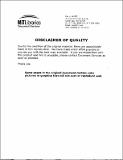Nitric oxide : cellular effects in vitro and in vivo
Author(s)
Wright, Teresa Leah, 1970-
DownloadFull printable version (8.833Mb)
Other Contributors
Massachusetts Institute of Technology. Division of Bioengineering and Environmental Health.
Advisor
Steven R. Tannenbaum.
Terms of use
Metadata
Show full item recordAbstract
The overall aim of this project was to investigate various cellular responses and toxic effects of nitric oxide, NO' and in vitro and in vivo. Nitric oxide gives rise to a complex spectrum of reactive species in oxygenated solution. The complexity of nitric oxide's chemistry is recapitulated in its effects on cells. Exposure to nitric oxide can result in changes on many different levels in cells ranging from protein and DNA damage, to damage to organelles and changes in gene expression, and even in cell death. Many models to study nitric oxide have been developed and will be used to study various responses to nitric oxide and related species. Nitric oxide and peroxynitrite-induced cellular damage has been and continues to be studied extensively using in vitro systems. Two systems have been used in this project, a delivery system for NO' as well as a cell line, which produces NO'. A Silasticʾ membrane delivery system can be used to treat bacteria or cells to mimic in vivo exposure to nitric oxide. Mutations induced by nitric oxide in a set of Salmonella tester strains can be studied utilizing this delivery system. Activated RAW264.7 macrophage cells have been used as an in vitro model of nitric oxide production and cytotoxicity SJL/J mice bearing the transplantable lymphoma RcsX have been established as an in vivo model of nitric oxide production and toxicity. (cont.) This in vivo mouse model can be used to test results found in vitro. Specifically, the relationship between nitric oxide production and prostaglandin synthesis and glutathione homeostasis can be explored. Glutathione was found to be induced by nitric oxide production in this model, and this increase was due to increases in y-glutamylcysteinyl synthetase activity. This thesis studied both the regulatory and toxic effects of nitric oxide, both endogenously produced and from exogenous sources.
Description
Thesis (Ph. D.)--Massachusetts Institute of Technology, Division of Bioengineering and Environmental Health, 2001. Includes bibliographical references.
Date issued
2001Department
Massachusetts Institute of Technology. Division of Bioengineering and Environmental Health; Massachusetts Institute of Technology. Department of Biological EngineeringPublisher
Massachusetts Institute of Technology
Keywords
Division of Bioengineering and Environmental Health.